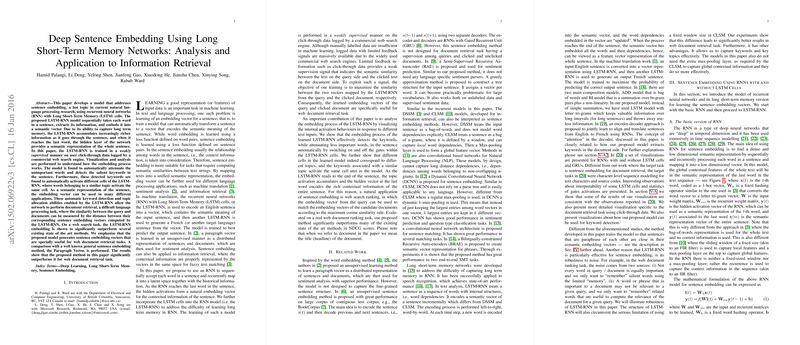Deep Sentence Embedding Using Long Short-Term Memory Networks: Analysis and Application to Information Retrieval
Abstract:
"Deep Sentence Embedding Using Long Short-Term Memory Networks: Analysis and Application to Information Retrieval" presents a model addressing the semantic embedding of sentences by utilizing Recurrent Neural Networks (RNN) with Long Short-Term Memory (LSTM) cells. By embedding sentences into semantically rich vectors, this model aims to enhance performance in tasks like web document retrieval.
Introduction
Sentence embedding is a significant task in NLP, where the aim is to represent sentences as dense vectors capturing their semantic content. Traditional methods, including Paragraph Vector and unsupervised approaches like Skip-Thought vectors, face limitations in capturing fine-grained sentence structures or in application to specific tasks like document retrieval. This work proposes an LSTM-RNN model to overcome these challenges by sequentially processing each word in a sentence, thereby embedding the sentence into a comprehensive semantic vector.
Model Architecture
The paper proposes a model where an RNN with LSTM cells processes each word in a sentence incrementally. At each time step, a word is encoded into the latent space, accumulating contextual information. The LSTM architecture, with input, output, and forget gates, enables the model to detect and embed salient keywords, effectively ignoring less significant words. This results in a robust semantic representation vector by the end of the sentence.
Weak Supervision with Click-Through Data
The LSTM-RNN model is trained using weak supervision on click-through data from a commercial web search engine. This weak supervision involves optimizing the model to maximize the similarity between query and clicked document embeddings. Notably, the model avoids the need for extensive manually labeled data, leveraging massive logged data with implicit user feedback for training.
Visualization and Analysis
The paper provides a detailed analysis of the embedding process by visualizing the activation behaviors of the LSTM cells. Key observations include:
- Contextual Information Accumulation: As the sequence progresses, the hidden states of the LSTM accumulate richer contextual information, enabling a comprehensive semantic representation by the sentence's end.
- Keyword Detection and Attenuation of Unimportant Words: Input gates selectively activate for significant keywords while attenuating irrelevant words. This selective activation supports the model's focus on relevant information.
- Topic Allocation: Different LSTM cells are found to correspond to distinct topics, effectively categorizing words by their semantic context within the sentence.
Performance Evaluation
The proposed LSTM-RNN model is evaluated on a web document retrieval task. The results are benchmarked against several state-of-the-art methods, including DSSM, CLSM, and traditional models like BM25 and PLSA. Notably, the LSTM-RNN model consistently outperformed these baselines by a significant margin.
Numerical Results:
- The LSTM-RNN model achieved a notable 33.1% NDCG@1, outperforming the best baseline (CLSM with a window size of 3) by 1.3% in the same metric.
- Comparison with general sentence embedding methods like Paragraph Vector (doc2vec) and Skip-Thought vectors highlighted the superiority of the task-specific LSTM-RNN approach in document retrieval.
Practical and Theoretical Implications
Practical Implications:
- The proposed model provides a powerful tool for web search engines, improving the relevance of retrieved documents in response to queries.
- The weak supervision framework offers a scalable solution for training models on large-scale data without extensive manual labeling.
Theoretical Implications:
- The use of LSTM-RNNs highlights the importance of capturing long-term dependencies and the contextual relationships between words in sentence embeddings.
- The findings on keyword detection and topic allocation within LSTM cells contribute to understanding how neural networks process and represent linguistic information.
Future Directions
Future developments could include:
- Extending to Broader NLP Tasks: Applying the LSTM-RNN sentence embedding methodology to other complex NLP tasks, such as question-answering and machine translation.
- Exploiting Prior Knowledge: Incorporating structured prior knowledge into the model to further refine embedding strategies and improve performance.
- Attention Mechanism Integration: Enhancing the model with attention mechanisms to dynamically align words in queries and documents, potentially boosting relevance and semantic matching capabilities.
Conclusion
The "Deep Sentence Embedding Using Long Short-Term Memory Networks" paper presents a significant advancement in sentence embedding for information retrieval. By leveraging LSTM-RNNs and weak supervision from click-through data, the model achieves superior performance in web document retrieval tasks, as evidenced by strong empirical results. This work sets a robust foundation for future exploration and application of deep learning techniques in semantic text processing and retrieval.
